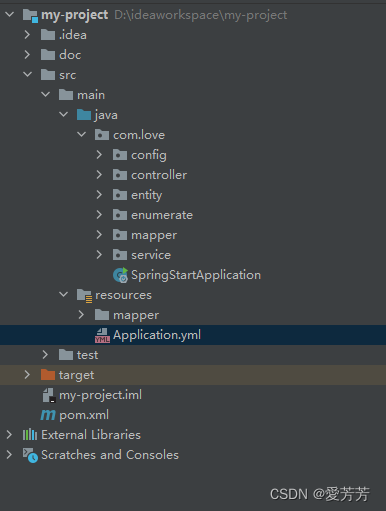
SpringBoot+OAuth2+Spring Security+Redis+mybatis-plus+mysql+swagger搭建实现
SpringBoot+OAuth2+Spring Security+Redis+mybatis-plus+mysql+swagger搭建实现
一.项目结构介绍
直接看图就行:

关键点都在config包里面,那我们看看config:
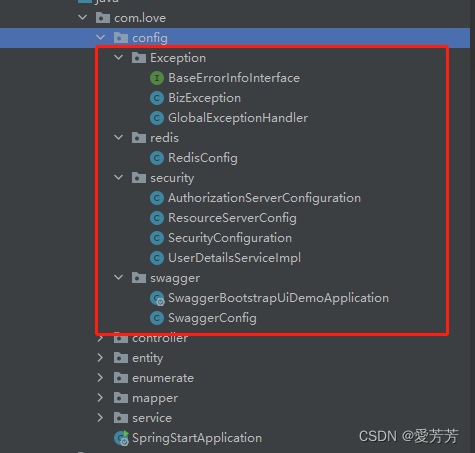
很明了,
- Excepition 是自定义异常封装类
- redis redis缓存配置
- security spring-security-oauth2相关配置,最最最重要部分
- swagger knife4j接口开发文档
- Application.yml spring配置文件(redis、数据源、oauth2等)
二.创建项目,这里是idea开发工具
左上角: File>New>Project

然后直接Next(这里你可能会遇到https://start.spring.io连接很慢或者直接连接失败,导致创建项目走不了下一步,那你可以选择Custom,输入https://start.aliyun.com):
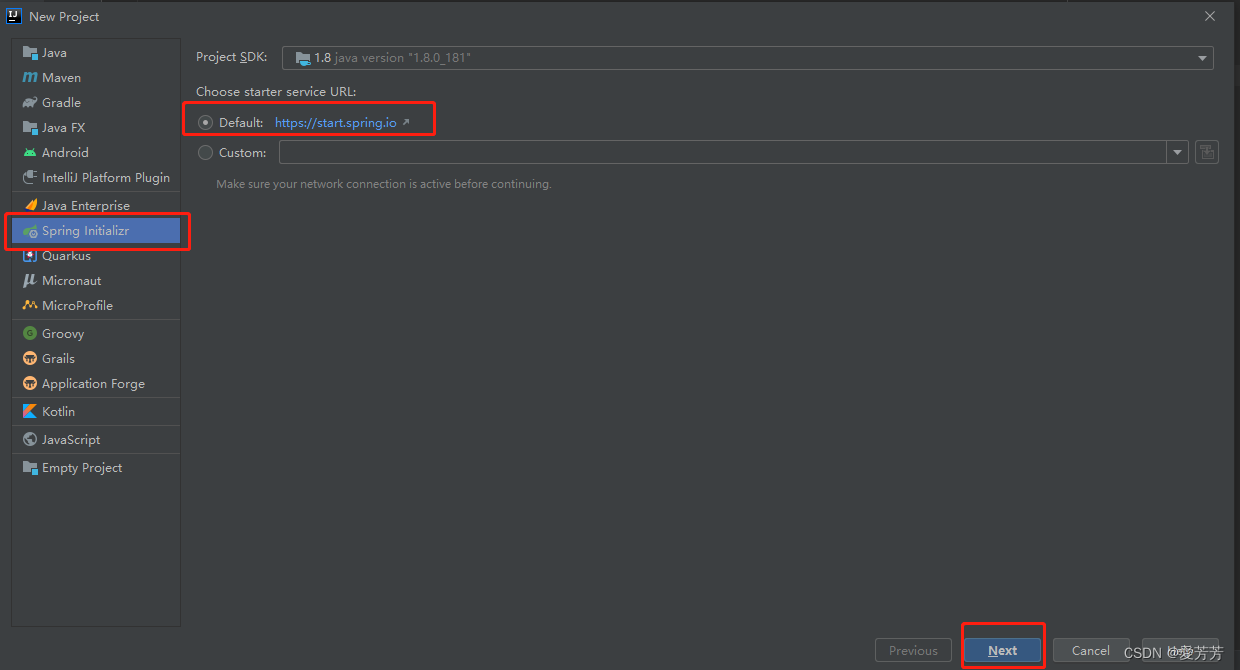
这是使用阿里云的:https://start.aliyun.com,当然创建后的项目可能不太一样,Application.yml阿里云应该是application.properties文件代替,其实都是大同小异的,语法稍微有些差别
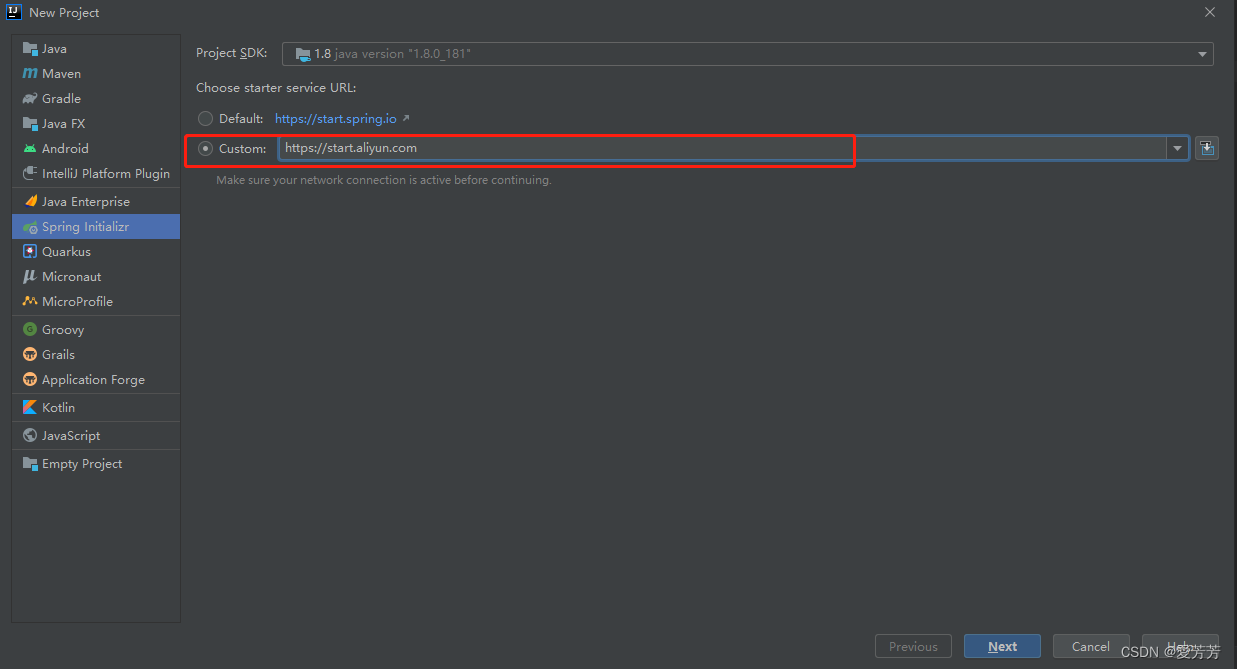
继续填好项目名称,包名等,记得Type选择Maven Next:
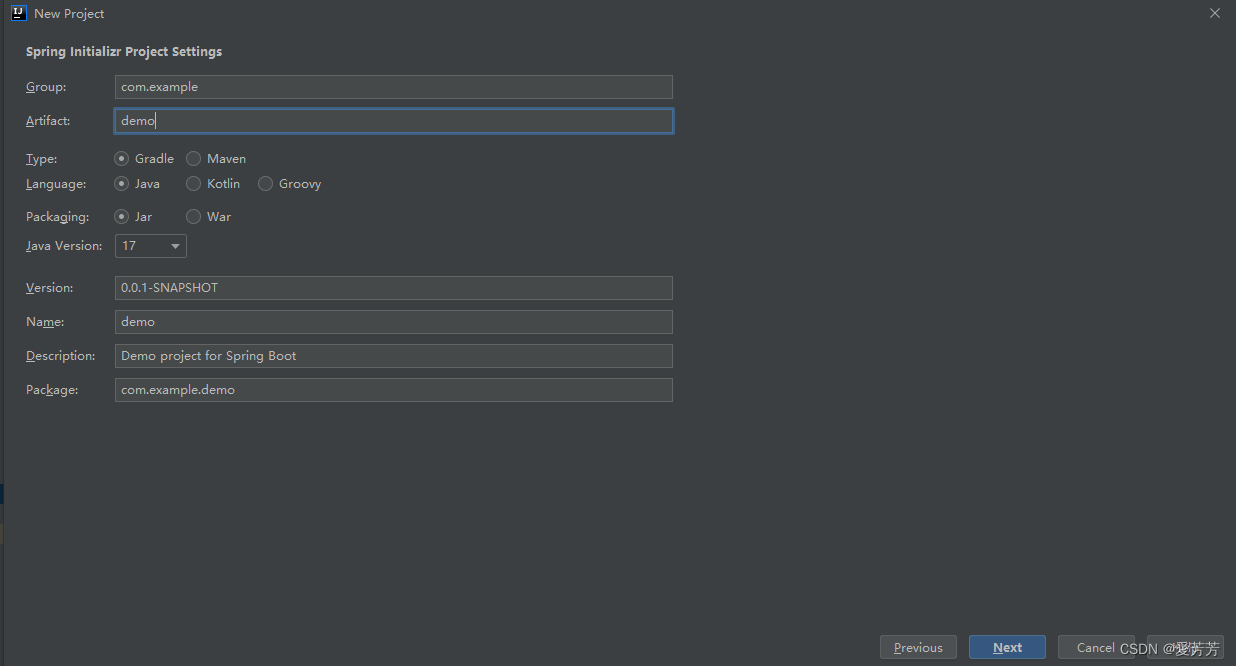
勾选依赖(按实际情况,也可后续在pom.xml里面手动灵活添加,也建议这么做),然后一直Next按照提示就创建完成了:
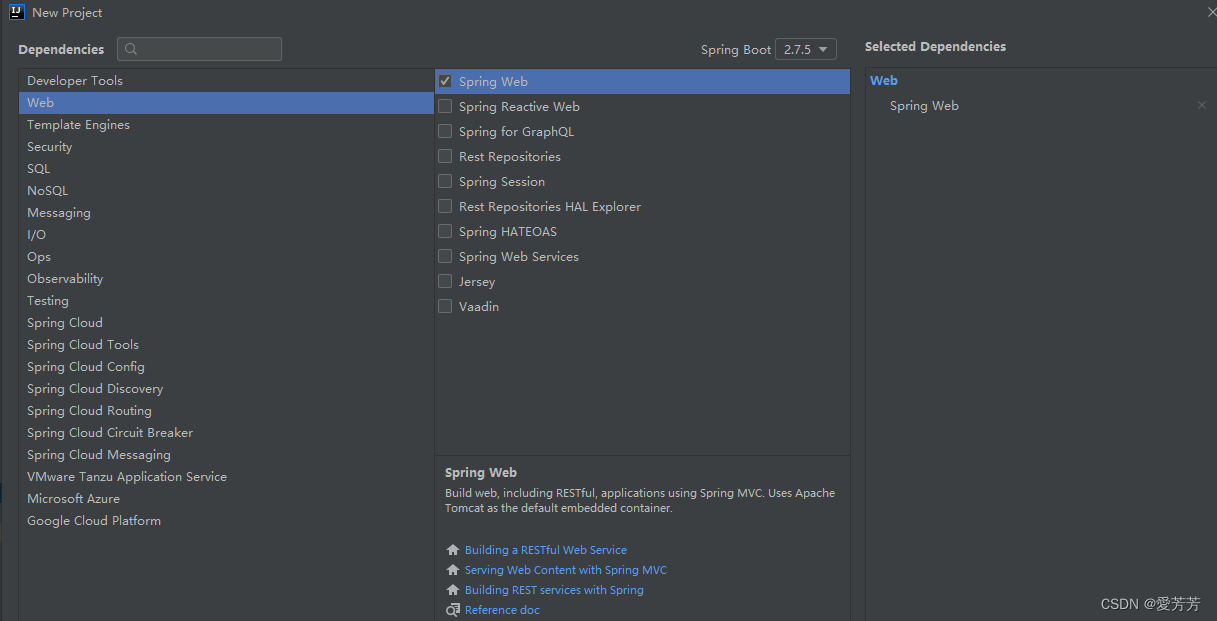
三.写代码前先搞好配置和下载好依赖,也就是pom文件啦~
pom文件不要缺,好好贴出来~
<?xml version="1.0" encoding="UTF-8"?>
<project xmlns="http://maven.apache.org/POM/4.0.0"
xmlns:xsi="http://www.w3.org/2001/XMLSchema-instance"
xsi:schemaLocation="http://maven.apache.org/POM/4.0.0 http://maven.apache.org/xsd/maven-4.0.0.xsd">
<modelVersion>4.0.0</modelVersion>
<groupId>com.love</groupId>
<artifactId>my-project</artifactId>
<version>1.0-SNAPSHOT</version>
<properties>
<mybatis.plus.version>3.5.2</mybatis.plus.version>
</properties>
<parent>
<groupId>org.springframework.boot</groupId>
<artifactId>spring-boot-starter-parent</artifactId>
<version>2.0.5.RELEASE</version>
</parent>
<dependencies>
<dependency>
<groupId>org.springframework.plugin</groupId>
<artifactId>spring-plugin-core</artifactId>
<version>2.0.0.RELEASE</version>
</dependency>
<dependency>
<groupId>org.springframework.plugin</groupId>
<artifactId>spring-plugin-metadata</artifactId>
<version>2.0.0.RELEASE</version>
</dependency>
<dependency>
<groupId>org.springframework.boot</groupId>
<artifactId>spring-boot-starter-web</artifactId>
</dependency>
<dependency>
<groupId>mysql</groupId>
<artifactId>mysql-connector-java</artifactId>
<version>8.0.25</version>
</dependency>
<dependency>
<groupId>com.baomidou</groupId>
<artifactId>mybatis-plus-boot-starter</artifactId>
<version>${mybatis.plus.version}</version>
</dependency>
<dependency>
<groupId>org.projectlombok</groupId>
<artifactId>lombok</artifactId>
</dependency>
<dependency>
<groupId>com.github.xiaoymin</groupId>
<artifactId>knife4j-spring-boot-starter</artifactId>
<version>2.0.8</version>
</dependency>
<dependency>
<groupId>com.github.xiaoymin</groupId>
<artifactId>knife4j-micro-spring-boot-starter</artifactId>
<version>2.0.8</version>
</dependency>
<dependency>
<groupId>junit</groupId>
<artifactId>junit</artifactId>
<scope>test</scope>
</dependency>
<dependency>
<groupId>org.springframework.boot</groupId>
<artifactId>spring-boot-starter-test</artifactId>
<scope>test</scope>
</dependency>
<dependency>
<groupId>org.springframework.boot</groupId>
<artifactId>spring-boot-starter-security</artifactId>
</dependency>
<!-- https://mvnrepository.com/artifact/org.springframework.security.oauth/spring-security-oauth2 -->
<dependency>
<groupId>org.springframework.security.oauth</groupId>
<artifactId>spring-security-oauth2</artifactId>
<version>2.3.3.RELEASE</version>
</dependency>
<dependency>
<groupId>org.springframework.boot</groupId>
<artifactId>spring-boot-starter-data-redis</artifactId>
<version>2.0.5.RELEASE</version>
</dependency>
</dependencies>
</project>
稍微讲解一下啊?那好:
1.mybatis-plus相关依赖
mybatis-plus版本号属性独立配置,mysql版本8.0.25,driver配置后面要注意
<properties>
<mybatis.plus.version>3.5.2</mybatis.plus.version>
</properties>
<dependency>
<groupId>mysql</groupId>
<artifactId>mysql-connector-java</artifactId>
<version>8.0.25</version>
</dependency>
<dependency>
<groupId>com.baomidou</groupId>
<artifactId>mybatis-plus-boot-starter</artifactId>
<version>${mybatis.plus.version}</version>
</dependency>
2.lombok
Lombok项目是一个java库,它可以自动插入到编辑器和构建工具中,增强java的性能。不需要再写getter、setter或equals方法,只要有一个注解,你的类就有一个功能齐全的构建器、自动记录变量等等。
<dependency>
<groupId>org.projectlombok</groupId>
<artifactId>lombok</artifactId>
</dependency>
3.swagger 开发文档
前后端分离开发少不了~
配置也很简单~,稍等,后面说道
<dependency>
<groupId>com.github.xiaoymin</groupId>
<artifactId>knife4j-spring-boot-starter</artifactId>
<version>2.0.8</version>
</dependency>
<dependency>
<groupId>com.github.xiaoymin</groupId>
<artifactId>knife4j-micro-spring-boot-starter</artifactId>
<version>2.0.8</version>
</dependency>
swagger长这样:

4.spring-security,oauth2集成依赖
这里可能你会遇到版本号或者各种冲突,那可以灵活更换依赖就行,冷静思考,多百度一下就行~
<dependency>
<groupId>org.springframework.boot</groupId>
<artifactId>spring-boot-starter-security</artifactId>
</dependency>
<!-- https://mvnrepository.com/artifact/org.springframework.security.oauth/spring-security-oauth2 -->
<dependency>
<groupId>org.springframework.security.oauth</groupId>
<artifactId>spring-security-oauth2</artifactId>
<version>2.3.3.RELEASE</version>
</dependency>
5.redis集成依赖
<dependency>
<groupId>org.springframework.boot</groupId>
<artifactId>spring-boot-starter-data-redis</artifactId>
<version>2.0.5.RELEASE</version>
</dependency>
三.pom完美解决了,接着就是Application.yml配置了
还是乖乖贴完整的好~
server:
port: 8089
# path: /love
error:
include-stacktrace: never
spring:
datasource:
url: jdbc:mysql://localhost:3306/sys?autoReconnect=true&useUnicode=true&characterEncoding=UTF-8&useSSL=false&allowMultiQueries=true&useAffectedRows=true&allowPublicKeyRetrieval=true
username: root
password: root
driver-class-name: com.mysql.cj.jdbc.Driver
redis:
# Redis数据库索引(默认为0)
database: 0
# Redis服务器地址
host: 127.0.0.1
# Redis服务器连接端口
port: 6379
# Redis服务器连接密码(默认为空)
password: root
# 连接池最大连接数(使用负值表示没有限制)
max-active: 20
# 连接池最大阻塞等待时间(使用负值表示没有限制)
max-wait: 1
# 连接池中的最大空闲连接
max-idle: 0
# 连接池中的最小空闲连接
min-idle: 0
# 连接超时时间(毫秒)
timeout: 1000
mybatis-plus:
mapper-locations: classpath*:mapper/*.xml
type-aliases-package: com.love.*.mapper
# oauth2.0配置
client:
oauth2:
# 客户端标识Id
client-id: appId
# 客户端安全码
secret: 123456
# 授权类型
grant_types:
- password
- refresh_token
# token 有效期
token-validity-time: 3600
refresh-token-validity-time: 3600
# 客户端访问范围
scopes:
- api
- all
好像可以说点什么,好像也没什么好说的,那还是说点吧~

1.项目访问端口配置8089
2.项目访问前缀路径path,如:/love,即是:http://127.0.0.1:8089/love
3.数据源配置,注意driver:com.mysql.cj.jdbc.Driver
4.redis配置看注释~
5.mybatis-plus包扫描配置,通配符扫描,mapper里的java和resources下面的mapper里的xml最好名称一致,会自动映射,没必要搞特殊找麻烦~
6.oauth2.0配置,接口请求要声明:客户端标识Id和客户端安全码,与配置一致,否则无权访问,看下图明了(postman截图):
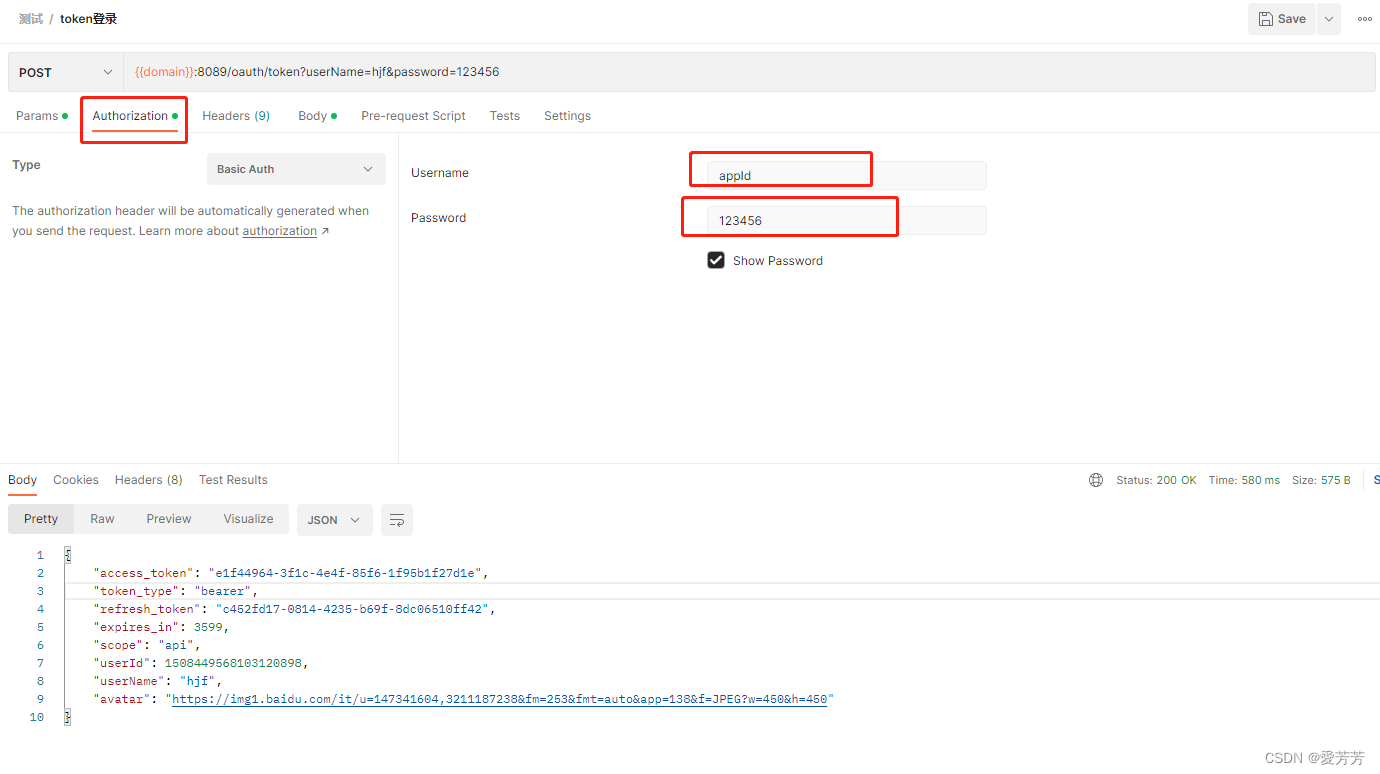
grant_types分为password,也就账密登录的意思,refresh_token比较特殊,大概可以理解为:token过期后通过refresh_token授权刷新token来续费,也就是告诉你没钱了,赶紧交钱,不然停止服务~

token有效期,3600秒,一个钟
四.redis配置类,序列化存储的关键,其实网上很多,类似
package com.love.config.redis;
import com.fasterxml.jackson.annotation.JsonAutoDetect;
import com.fasterxml.jackson.annotation.PropertyAccessor;
import com.fasterxml.jackson.databind.ObjectMapper;
import org.springframework.context.annotation.Bean;
import org.springframework.context.annotation.Configuration;
import org.springframework.data.redis.connection.RedisConnectionFactory;
import org.springframework.data.redis.core.RedisTemplate;
import org.springframework.data.redis.serializer.Jackson2JsonRedisSerializer;
import org.springframework.data.redis.serializer.StringRedisSerializer;
/**
* @author hjf
* @date 2022-10-24 10:33
* @describe redis配置
*/
@Configuration //使用注解注入配置,必须要添加,这样application.properties中的配置才能在redis中生效,添加@Configuration之后,spring 会自动扫描注入
public class RedisConfig {
@Bean
@SuppressWarnings("all")
public RedisTemplate<String, Object> redisTemplate(RedisConnectionFactory factory) {
// 我们为了自己开发方便,一般直接使用 <String,Object>
RedisTemplate<String, Object> template = new RedisTemplate<String,Object>();
template.setConnectionFactory(factory);
// Json序列化配置
Jackson2JsonRedisSerializer jackson2JsonRedisSerializer = new Jackson2JsonRedisSerializer(Object.class);
ObjectMapper om = new ObjectMapper();
om.setVisibility(PropertyAccessor.ALL, JsonAutoDetect.Visibility.ANY);
om.enableDefaultTyping(ObjectMapper.DefaultTyping.NON_FINAL);
jackson2JsonRedisSerializer.setObjectMapper(om);
// String 的序列化
StringRedisSerializer stringRedisSerializer = new StringRedisSerializer();
// key采用String的序列化方式
template.setKeySerializer(stringRedisSerializer);
// hash的key也采用String的序列化方式
template.setHashKeySerializer(stringRedisSerializer);
// value序列化方式采用jackson
template.setValueSerializer(jackson2JsonRedisSerializer);
// hash的value序列化方式采用jackson
template.setHashValueSerializer(jackson2JsonRedisSerializer);
template.afterPropertiesSet();
return template;
}
}
五.AuthorizationServerConfiguration实现类
token存储userId,userName和头像avatar
package com.love.config.security;
import com.love.entity.vo.LoginUser;
import com.love.entity.base.ClientOauth2DataConfiguration;
import org.springframework.context.annotation.Configuration;
import org.springframework.security.authentication.AuthenticationManager;
import org.springframework.security.crypto.password.PasswordEncoder;
import org.springframework.security.oauth2.common.DefaultOAuth2AccessToken;
import org.springframework.security.oauth2.config.annotation.configurers.ClientDetailsServiceConfigurer;
import org.springframework.security.oauth2.config.annotation.web.configuration.AuthorizationServerConfigurerAdapter;
import org.springframework.security.oauth2.config.annotation.web.configuration.EnableAuthorizationServer;
import org.springframework.security.oauth2.config.annotation.web.configurers.AuthorizationServerEndpointsConfigurer;
import org.springframework.security.oauth2.config.annotation.web.configurers.AuthorizationServerSecurityConfigurer;
import org.springframework.security.oauth2.provider.token.store.redis.RedisTokenStore;
import javax.annotation.Resource;
import java.util.LinkedHashMap;
/**
* @author hjf
* @date 2022-10-24 14:10
* @describe 授权配置类
*/
@Configuration
@EnableAuthorizationServer
public class AuthorizationServerConfiguration extends AuthorizationServerConfigurerAdapter {
@Resource
private UserDetailsServiceImpl userService;
@Resource
private RedisTokenStore redisTokenStore;
/**
* 管理器
*/
@Resource
private AuthenticationManager authenticationManager;
/**
* 密码编码器
*/
@Resource
private PasswordEncoder passwordEncoder;
/**
* 客户端配置类
*/
@Resource
private ClientOauth2DataConfiguration oauth2DataConfiguration;
/**
* 客户端配置授权模型
* @param clients
* @throws Exception
*/
@Override
public void configure(ClientDetailsServiceConfigurer clients) throws Exception {
clients.inMemory().withClient(oauth2DataConfiguration.getClientId())
.secret(passwordEncoder.encode(oauth2DataConfiguration.getSecret()))
.authorizedGrantTypes(oauth2DataConfiguration.getGrantTypes()) // token 授权类型
.accessTokenValiditySeconds(oauth2DataConfiguration.getTokenValidityTime()) // token 过期时间
.refreshTokenValiditySeconds(oauth2DataConfiguration.getRefreshTokenValidityTime()) // token 刷新过期时间
.scopes(oauth2DataConfiguration.getScopes());
}
/**
* 配置令牌端点的安全约束
* @param security
* @throws Exception
*/
@Override
public void configure(AuthorizationServerSecurityConfigurer security) throws Exception {
// 允许访问 token 的公钥,默认 /oauth/token_key 受保护的
security.tokenKeyAccess("permitAll()")
// 允许访问 token 的状态,默认 /oauth/check_token 受保护的
.checkTokenAccess("permitAll()");
}
@Override
public void configure(AuthorizationServerEndpointsConfigurer endpoints) throws Exception {
// 认证器
endpoints.authenticationManager(authenticationManager)
// 具体登陆方法
.userDetailsService(userService)
// token 存储方式 redis
.tokenStore(redisTokenStore)
// 令牌增强对象 , 增强返回的结果
.tokenEnhancer((accessToken, authentication) ->{
// 获取用户信息,然后设置
LoginUser loginUser = (LoginUser) authentication.getPrincipal();
LinkedHashMap<String, Object> map = new LinkedHashMap<>();
map.put("userId",loginUser.getId());
map.put("userName",loginUser.getUsername());
map.put("avatar", loginUser.getAvatar());
DefaultOAuth2AccessToken token = (DefaultOAuth2AccessToken) accessToken;
token.setAdditionalInformation(map);
return token;
});
}
}
重要点
private UserDetailsServiceImpl userService;
自定义类UserDetailsServiceImpl实现security的UserDetailsService,并且重写方法loadUserByUsername:
package com.love.config.security;
import com.baomidou.mybatisplus.core.conditions.query.QueryWrapper;
import com.love.entity.vo.LoginUser;
import com.love.entity.UserInfo;
import com.love.service.UserInfoService;
import lombok.RequiredArgsConstructor;
import lombok.extern.slf4j.Slf4j;
import org.springframework.beans.BeanUtils;
import org.springframework.security.core.userdetails.UserDetails;
import org.springframework.security.core.userdetails.UserDetailsService;
import org.springframework.security.core.userdetails.UsernameNotFoundException;
import org.springframework.stereotype.Service;
/**
* @author hjf
* @date 2022-10-24 14:24
* @describe
*/
@Slf4j
@Service
@RequiredArgsConstructor
public class UserDetailsServiceImpl implements UserDetailsService {
private final UserInfoService userInfoService;
/**
* 用户密码登录
* @param username 用户名
* @return UserDetails
* @throws UsernameNotFoundException
*/
@Override
public UserDetails loadUserByUsername(String username) throws UsernameNotFoundException {
// 根据用户名查询用户的接口
QueryWrapper<UserInfo> wrapper = new QueryWrapper<>();
wrapper.eq("user_name", username);
UserInfo userInfo = userInfoService.getOne(wrapper);
if (userInfo == null) {
throw new UsernameNotFoundException("用户名不存在!");
}
return getUserDetails(userInfo);
}
/**
* 构建用户信息
* @param userInfo
* @return 用户详情
*/
private LoginUser getUserDetails(UserInfo userInfo) {
// UserVO是用户实体类,AuthUserDetails是SpringSecurity认证用户详情对象
LoginUser userDetail = new LoginUser();
// 1. 用户详情封装(此处由于是继承关系,可以使用属性复制的方式)
BeanUtils.copyProperties(userInfo, userDetail);
return userDetail;
}
}
逻辑很简单,根据用户名username数据库查询是否存在用户,不存在直接抛对应异常,你会看到这里为什么没有密码判断,按理说登录应该是账号密码一起判断才对,然后会提示:账号或密码错误 之类的~稍等,主要是security帮你处理掉了,后面说道
六.ResourceServerConfig资源配置类,对外开放访问资源
package com.love.config.security;
import org.springframework.context.annotation.Configuration;
import org.springframework.security.config.annotation.web.builders.HttpSecurity;
import org.springframework.security.oauth2.config.annotation.web.configuration.EnableResourceServer;
import org.springframework.security.oauth2.config.annotation.web.configuration.ResourceServerConfigurerAdapter;
import org.springframework.security.oauth2.config.annotation.web.configurers.ResourceServerSecurityConfigurer;
import org.springframework.security.oauth2.provider.token.store.redis.RedisTokenStore;
import javax.annotation.Resource;
/**
* @author hjf
* @date 2022-10-24 18:09
* @describe 资源配置类
*/
@Configuration
@EnableResourceServer
public class ResourceServerConfig extends ResourceServerConfigurerAdapter {
@Resource
private RedisTokenStore redisTokenStore;
@Override
public void configure(HttpSecurity http) throws Exception {
http.authorizeRequests().anyRequest()
.authenticated()
.and()
.requestMatchers().antMatchers("/user/**");
}
@Override
public void configure(ResourceServerSecurityConfigurer resources) throws Exception {
// 设置token存储
resources.tokenStore(redisTokenStore);
}
}
若没有配置路径,结果:
当然配置了,除了白名单,其他也还要带上token访问才行~
{
"timestamp": "2022-11-07T08:04:02.264+0000",
"status": 403,
"error": "Forbidden",
"message": "Access Denied",
"path": "/user/getUserInfoById"
}
七.SecurityConfiguration,白名单配置放行,自定义加密配置
package com.love.config.security;
import org.springframework.context.annotation.Bean;
import org.springframework.context.annotation.Configuration;
import org.springframework.data.redis.connection.RedisConnectionFactory;
import org.springframework.security.authentication.AuthenticationManager;
import org.springframework.security.config.annotation.web.builders.HttpSecurity;
import org.springframework.security.config.annotation.web.configuration.EnableWebSecurity;
import org.springframework.security.config.annotation.web.configuration.WebSecurityConfigurerAdapter;
import org.springframework.security.crypto.bcrypt.BCryptPasswordEncoder;
import org.springframework.security.crypto.password.PasswordEncoder;
import org.springframework.security.oauth2.provider.token.store.redis.RedisTokenStore;
import javax.annotation.Resource;
/**
* @author hjf
* @date 2022-10-24 14:23
* @describe
*/
@Configuration
@EnableWebSecurity
public class SecurityConfiguration extends WebSecurityConfigurerAdapter {
/**
* 注入redis 连接工厂
*/
@Resource
private RedisConnectionFactory redisConnectionFactory;
/**
* 初始化 redisTokenStore 用户将token 放入redis
* @return
*/
@Bean
public RedisTokenStore redisTokenStore(){
RedisTokenStore redisTokenStore = new RedisTokenStore(redisConnectionFactory);
redisTokenStore.setPrefix("TOKEN:");
return redisTokenStore;
}
/**
* http请求设置
*/
@Override
protected void configure(HttpSecurity http) throws Exception {
http.csrf().disable()
.authorizeRequests()
// 放行
.antMatchers(
"/oauth/**",
"/actuator/**",
"/doc.html/**",
"/favicon.ico",
"/webjars/**",
"/swagger-resources/**",
"/v2/api-docs/**")
.permitAll()
.and()
.authorizeRequests()
.anyRequest()
// 其他需要拦截
.authenticated();
}
/**
* 初始化管理对象
*/
@Override
@Bean
public AuthenticationManager authenticationManager() throws Exception {
return super.authenticationManager();
}
/**
* 密码加密算法
* @return 加密算法,BCrypt实现加密器可以有效防止撞库
*/
@Bean
public PasswordEncoder passwordEncoder(){
PasswordEncoder encoder = new BCryptPasswordEncoder();
return encoder;
}
}
token存放key:
redisTokenStore.setPrefix(“TOKEN:”);
看看都存了什么?下图,真实产品肯定没必要存这么多,这里就可以再深入自定义处理了,暂时到这里先吧~

密码怎么加密,这里提高一个test测试类:
package com.love;
import org.junit.Test;
import org.junit.runner.RunWith;
import org.springframework.security.crypto.bcrypt.BCryptPasswordEncoder;
import org.springframework.test.context.junit4.SpringRunner;
@RunWith(SpringRunner.class)
public class UserInfoTest {
@Test
public void getUserInfoVo() {
String myPassword = "";//你的密码
//密码加密
myPassword = new BCryptPasswordEncoder().encode(myPassword );
System.out.println("myPassword ="+myPassword );
}
}
八.swagger配置,两个类,几乎复制拷贝就行~
SwaggerBootstrapUiDemoApplication:
package com.love.config.swagger;
import org.springframework.boot.autoconfigure.SpringBootApplication;
import org.springframework.web.servlet.config.annotation.ResourceHandlerRegistry;
import org.springframework.web.servlet.config.annotation.WebMvcConfigurer;
@SpringBootApplication
public class SwaggerBootstrapUiDemoApplication implements WebMvcConfigurer {
@Override
public void addResourceHandlers(ResourceHandlerRegistry registry) {
registry.addResourceHandler("doc.html").addResourceLocations("classpath:/META-INF/resources/");
registry.addResourceHandler("/webjars/**").addResourceLocations("classpath:/META-INF/resources/webjars/");
}
}
SwaggerConfig:
package com.love.config.swagger;
import com.github.xiaoymin.knife4j.spring.annotations.EnableKnife4j;
import org.springframework.context.annotation.Bean;
import org.springframework.context.annotation.Configuration;
import org.springframework.context.annotation.Import;
import springfox.bean.validators.configuration.BeanValidatorPluginsConfiguration;
import springfox.documentation.builders.ApiInfoBuilder;
import springfox.documentation.builders.PathSelectors;
import springfox.documentation.builders.RequestHandlerSelectors;
import springfox.documentation.service.ApiInfo;
import springfox.documentation.spi.DocumentationType;
import springfox.documentation.spring.web.plugins.Docket;
import springfox.documentation.swagger2.annotations.EnableSwagger2WebMvc;
/**
* @author hjf
* @date 2022-10-11 12:11
* @describe Swagger开发文档
*/
@Configuration
@EnableSwagger2WebMvc
@EnableKnife4j
@Import(BeanValidatorPluginsConfiguration.class)
public class SwaggerConfig {
@Bean
public Docket createRestApi() {
return new Docket(DocumentationType.SWAGGER_2)
.useDefaultResponseMessages(false)
.apiInfo(apiInfo())
.select()
.apis(RequestHandlerSelectors.basePackage("com.love"))
.paths(PathSelectors.any())
.build();
}
private ApiInfo apiInfo() {
return new ApiInfoBuilder().version("1.0.0")
.title("爱芳芳-Spring Cloud Swagger2 文档")
.description("爱芳芳-Spring Cloud Swagger2 文档")
.termsOfServiceUrl("https://blog.csdn.net/lucky_fang?type=blog")
.build();
}
}
记得改成自己的包名~
十.OauthController,登录获取凭证token
package com.love.controller;
import io.swagger.annotations.Api;
import lombok.RequiredArgsConstructor;
import lombok.extern.slf4j.Slf4j;
import org.springframework.security.oauth2.common.DefaultOAuth2AccessToken;
import org.springframework.security.oauth2.common.OAuth2AccessToken;
import org.springframework.security.oauth2.provider.endpoint.TokenEndpoint;
import org.springframework.security.oauth2.provider.token.TokenStore;
import org.springframework.web.HttpRequestMethodNotSupportedException;
import org.springframework.web.bind.annotation.*;
import java.security.Principal;
import java.util.LinkedHashMap;
import java.util.Map;
/**
* @author hjf
* @date 2022-10-24 15:19
* @describe 登录认证
*/
@Api(tags = "权限控制")
@Slf4j
@RestController
@RequiredArgsConstructor
@RequestMapping("/oauth")
public class OauthController {
/**
* 返回增强
*/
private final TokenEndpoint tokenEndpoint;
private final TokenStore tokenStore;
@PostMapping("/login")
public Map<String, Object> postAccessToken(Principal principal, @RequestParam Map<String,String> param) throws HttpRequestMethodNotSupportedException {
return custom(tokenEndpoint.postAccessToken(principal, param).getBody());
}
private Map<String,Object> custom(OAuth2AccessToken oAuth2AccessToken){
DefaultOAuth2AccessToken token = (DefaultOAuth2AccessToken) oAuth2AccessToken;
Map<String,Object> data = new LinkedHashMap(token.getAdditionalInformation());
data.put("accessToken",token.getValue());
data.put("expireIn", token.getExpiresIn());
data.put("scopes", token.getScope());
if (token.getRefreshToken() != null){
data.put("refreshToken",token.getRefreshToken().getValue());
}
return data;
}
/**
* 移除access_token和refresh_token,退出登录
*
* @param access_token 登录token
*/
@DeleteMapping(value = "/removeToken", params = "access_token")
public void removeToken(Principal principal, String access_token) {
OAuth2AccessToken accessToken = tokenStore.readAccessToken(access_token);
if (accessToken != null) {
// 移除access_token
tokenStore.removeAccessToken(accessToken);
// 移除refresh_token
if (accessToken.getRefreshToken() != null) {
tokenStore.removeRefreshToken(accessToken.getRefreshToken());
}
}
}
}
postman请求截图
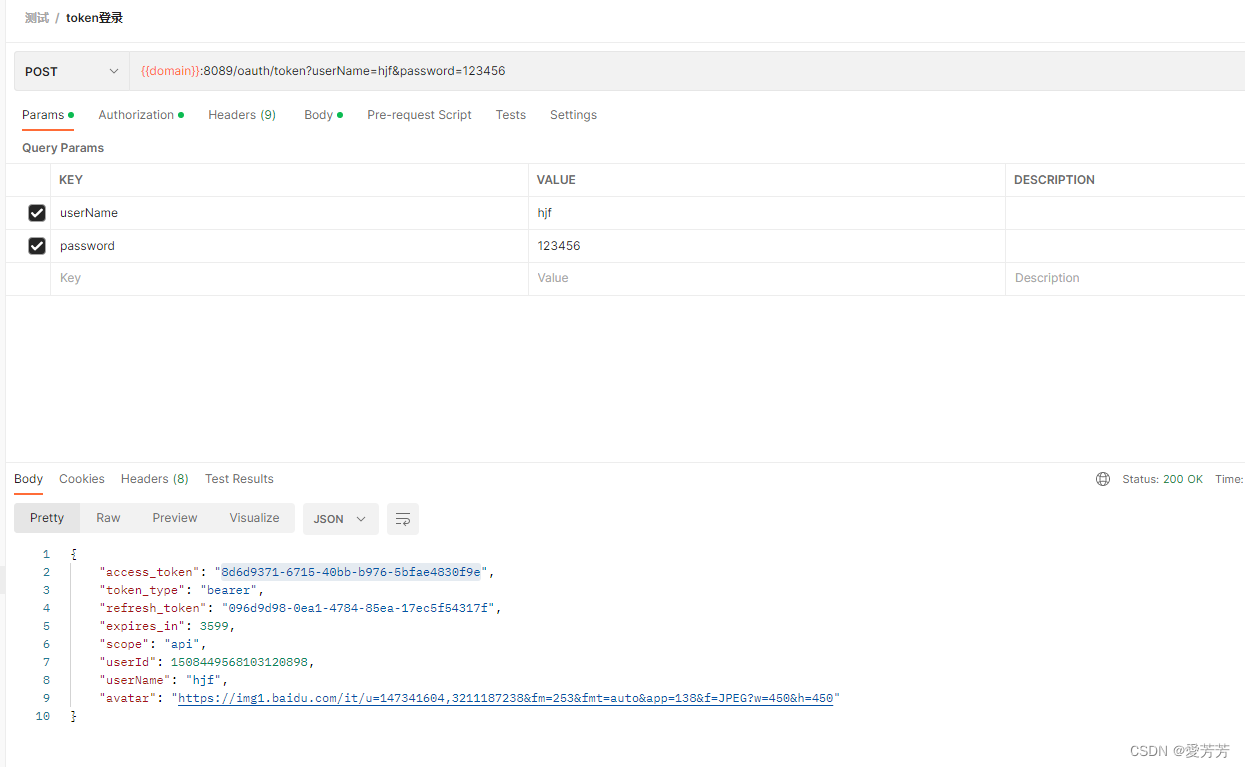
记得配置这个,上面已经说过:
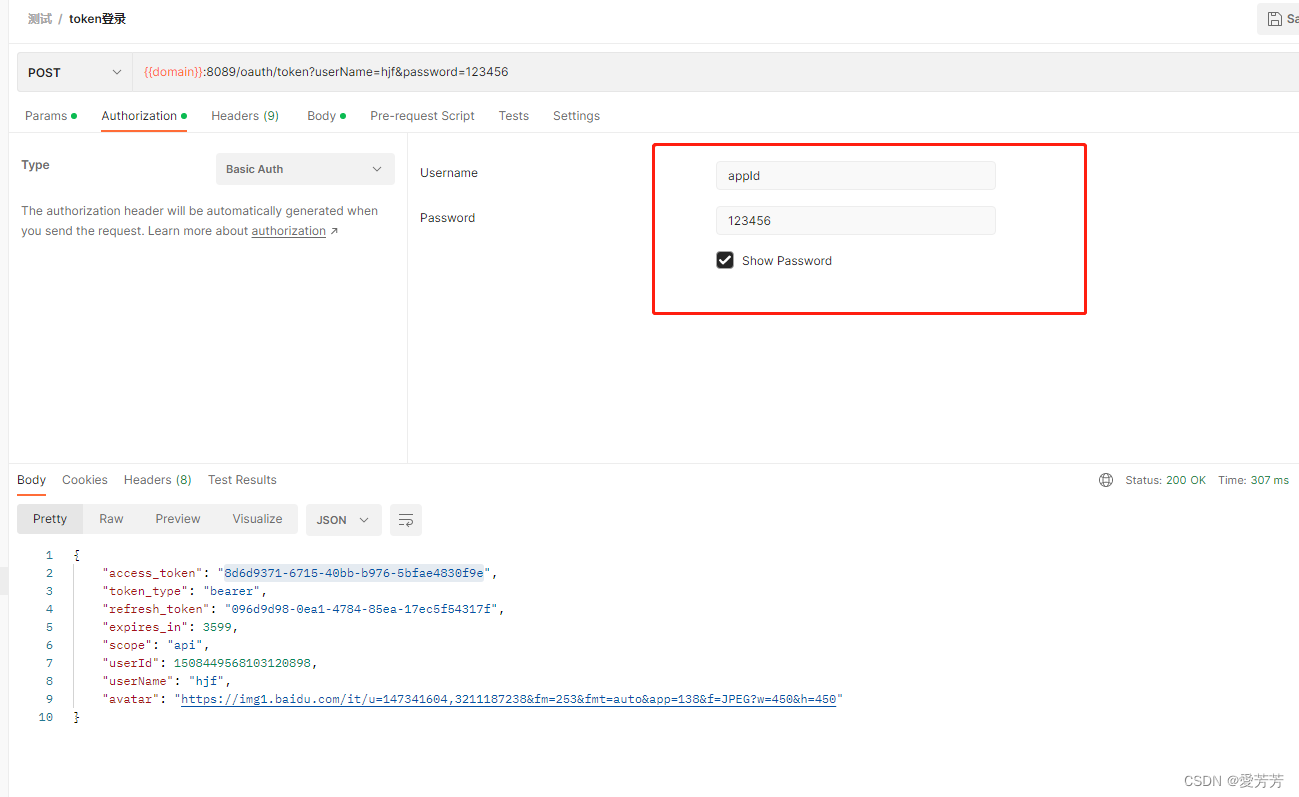
退出登录,清除token,redis同时也会清除:
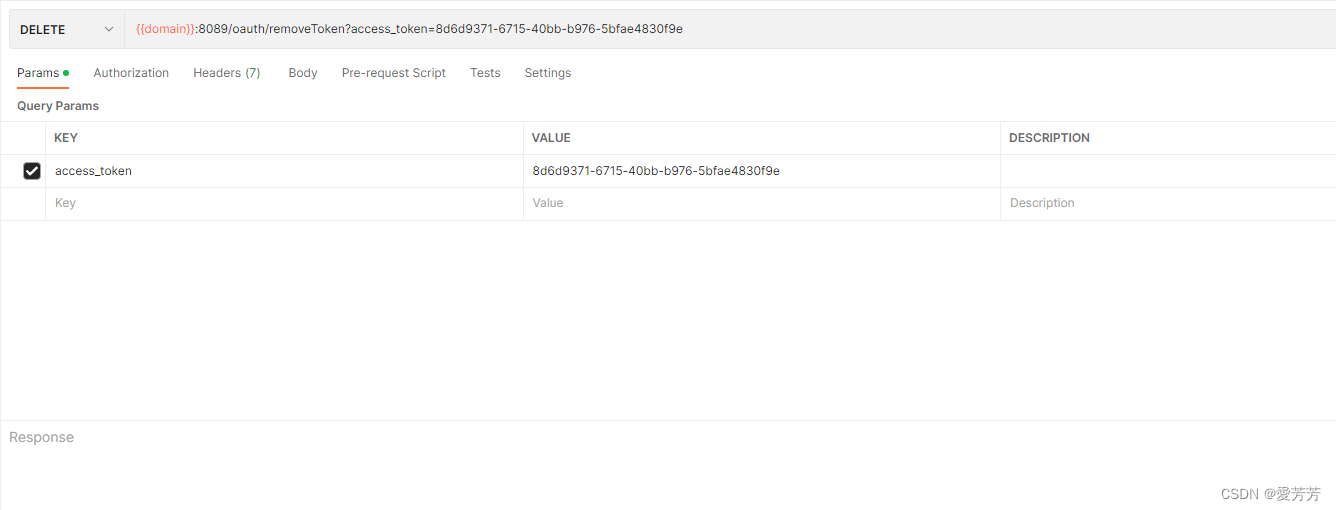
十一.其他杂七杂八的一并乖乖贴上
LoginUser:
package com.love.entity.vo;
import com.baomidou.mybatisplus.core.toolkit.StringUtils;
import com.love.entity.UserInfo;
import io.swagger.annotations.ApiModelProperty;
import lombok.AllArgsConstructor;
import lombok.Data;
import lombok.NoArgsConstructor;
import org.springframework.security.core.GrantedAuthority;
import org.springframework.security.core.authority.AuthorityUtils;
import org.springframework.security.core.authority.SimpleGrantedAuthority;
import org.springframework.security.core.userdetails.UserDetails;
import java.util.Collection;
import java.util.List;
import java.util.stream.Collectors;
import java.util.stream.Stream;
/**
* @author hjf
* @date 2022-10-24 14:27
* @describe
*/
@Data
@NoArgsConstructor
@AllArgsConstructor
public class LoginUser extends UserInfo implements UserDetails {
@ApiModelProperty(value = "凭证")
private List<GrantedAuthority> authorities;
@Override
public String getPassword() {
return this.password;
}
@Override
public String getUsername() {
return this.userName;
}
@Override
public boolean isAccountNonExpired() {
return true;
}
@Override
public boolean isAccountNonLocked() {
return true;
}
@Override
public boolean isCredentialsNonExpired() {
return true;
}
@Override
public boolean isEnabled() {
return this.status != 1;
}
private String roles;
//** 获取角色信息
@Override
public Collection<? extends GrantedAuthority> getAuthorities() {
if (StringUtils.isNotBlank(this.roles)){
//获取数据库中角色
this.authorities = Stream.of(this.roles.split(",")).map(role ->{
return new SimpleGrantedAuthority(role);
}).collect(Collectors.toList());
}else{
// 如果角色为空
this.authorities = AuthorityUtils
.commaSeparatedStringToAuthorityList("ROLE_USER");
}
return this.authorities;
}
}
UserInfo:
package com.love.entity;
import com.baomidou.mybatisplus.annotation.TableName;
import com.love.entity.base.BaseEntity;
import io.swagger.annotations.ApiModelProperty;
import lombok.AllArgsConstructor;
import lombok.Data;
import lombok.NoArgsConstructor;
/**
* @author hjf
* @date 2022-10-19 10:24
* @describe 用户
*/
@Data
@NoArgsConstructor
@AllArgsConstructor
@TableName(value ="user_info")
public class UserInfo extends BaseEntity {
@ApiModelProperty(value = "用户名称")
public String userName;
@ApiModelProperty(value = "登录密码 加密")
public String password;
@ApiModelProperty(value = "登录密码 原始密码")
public String originalPassword;
@ApiModelProperty(value = "头像")
public String avatar;
/**
* {@link com.love.enumerate.Gender}
*/
@ApiModelProperty(value = "性别")
public Integer gender;
/**
* {@link com.love.enumerate.YesOrNo}
*/
@ApiModelProperty(value = "状态")
public Integer status;
@ApiModelProperty(value = "备注")
public String remark;
}
BaseEntity:
package com.love.entity.base;
import com.baomidou.mybatisplus.annotation.*;
import com.fasterxml.jackson.annotation.JsonFormat;
import com.fasterxml.jackson.databind.annotation.JsonDeserialize;
import com.fasterxml.jackson.databind.annotation.JsonSerialize;
import com.fasterxml.jackson.datatype.jsr310.deser.LocalDateTimeDeserializer;
import com.fasterxml.jackson.datatype.jsr310.ser.LocalDateTimeSerializer;
import io.swagger.annotations.ApiModelProperty;
import lombok.AllArgsConstructor;
import lombok.Data;
import lombok.NoArgsConstructor;
import java.io.Serializable;
import java.time.LocalDateTime;
/**
* @author hjf
* @date 2022-10-19 10:26
* @describe 基础类
*/
@Data
@NoArgsConstructor
@AllArgsConstructor
public class BaseEntity implements Serializable {
private static final long serialVersionUID = 1L;
@TableId(type = IdType.ASSIGN_ID)
@ApiModelProperty(name = "id", value = "表主键")
public Long id;
@ApiModelProperty(name = "deleted", value = "逻辑删除标记 是否已删除: 0否 1是")
@TableLogic
public Integer deleted;
@JsonFormat(pattern = "yyyy-MM-dd HH:mm:ss", timezone = "GMT+8")
@JsonDeserialize(using = LocalDateTimeDeserializer.class)
@JsonSerialize(using = LocalDateTimeSerializer.class)
@TableField(fill = FieldFill.INSERT)
@ApiModelProperty(name = "createTime", value = "创建时间")
public LocalDateTime createTime;
@JsonFormat(pattern = "yyyy-MM-dd HH:mm:ss", timezone = "GMT+8")
@JsonDeserialize(using = LocalDateTimeDeserializer.class)
@JsonSerialize(using = LocalDateTimeSerializer.class)
@TableField(fill = FieldFill.INSERT_UPDATE)
@ApiModelProperty(name = "updateTime", value = "修改时间")
public LocalDateTime updateTime;
}
UserInfoMapper.xml:
<?xml version="1.0" encoding="UTF-8"?>
<!DOCTYPE mapper
PUBLIC "-//mybatis.org//DTD Mapper 3.0//EN"
"http://mybatis.org/dtd/mybatis-3-mapper.dtd">
<mapper namespace="com.love.mapper.UserInfoMapper">
<!--详情-->
<select id="getByUserName" resultType="com.love.entity.UserInfo">
select
id,
user_name,
password,
avatar,
gender,
remark,
status,
deleted,
create_time,
update_time
from
user_info
where
user_name = #{userName}
limit 1
</select>
<!--详情-->
<select id="getById" resultType="com.love.entity.UserInfo">
select
id,
user_name,
password,
avatar,
gender,
remark,
status,
deleted,
create_time,
update_time
from
user_info
where
id = #{id}
limit 1
</select>
</mapper>
UserInfoMapper.java:
package com.love.mapper;
import com.baomidou.mybatisplus.core.mapper.BaseMapper;
import com.love.entity.UserInfo;
import org.apache.ibatis.annotations.Param;
/**
* @author hjf
* @date 2022-10-19 10:26
* @describe 用户mapper
*/
public interface UserInfoMapper extends BaseMapper<UserInfo> {
/**
* 用户详情
*
* @param userName 用户名
* @return UserInfo
*/
UserInfo getByUserName(@Param("userName") String userName);
/**
* 用户详情
*
* @param id 用户ID
* @return UserInfo
*/
UserInfo getById(@Param("id") Long id);
}
UserInfoService:
package com.love.service;
import com.baomidou.mybatisplus.extension.service.IService;
import com.love.entity.base.Result;
import com.love.entity.UserInfo;
/**
* @author hjf
* @date 2022-10-19 10:26
* @describe 用户service
*/
public interface UserInfoService extends IService<UserInfo> {
/**
* 用户登录
*
* @return Result<UserInfo>
*/
Result<UserInfo> login(String userName,String password);
/**
* 用户详情
*
* @param id
* @return Result<UserInfo>
*/
Result<UserInfo> getUserInfoById(Long id);
}
UserInfoServiceImpl:
package com.love.service.impl;
import com.baomidou.mybatisplus.extension.service.impl.ServiceImpl;
import com.love.entity.UserInfo;
import com.love.entity.base.Result;
import com.love.enumerate.YesOrNo;
import com.love.mapper.UserInfoMapper;
import com.love.service.UserInfoService;
import lombok.RequiredArgsConstructor;
import lombok.extern.slf4j.Slf4j;
import org.springframework.security.crypto.bcrypt.BCryptPasswordEncoder;
import org.springframework.security.crypto.password.PasswordEncoder;
import org.springframework.stereotype.Service;
/**
* @author hjf
* @date 2022-10-19 10:26
* @describe 用户service
*/
@Slf4j
@Service
@RequiredArgsConstructor
public class UserInfoServiceImpl extends ServiceImpl<UserInfoMapper, UserInfo> implements UserInfoService {
private final UserInfoMapper userInfoMapper;
/**
* 用户登录
*
* @return Result<UserInfo>
*/
@Override
public Result<UserInfo> login(String userName,String password) {
UserInfo userInfo = userInfoMapper.getByUserName(userName);
if(userInfo != null){
if(userInfo.getDeleted().equals(YesOrNo.YES.getValue())){
return Result.failMsg("登录失败,账号已注销");
}
if(userInfo.getStatus().equals(YesOrNo.YES.getValue())){
return Result.failMsg("登录失败,账号已禁用,请联系客服人员");
}
PasswordEncoder encoder = new BCryptPasswordEncoder();
boolean matches = encoder.matches(password, userInfo.getPassword());
if (!matches) {
return Result.failMsg("账号或密码错误");
}
return Result.OK(userInfo);
}else{
return Result.failMsg("账号或密码错误");
}
}
/**
* 获取用户详情
*
* @return Result<UserInfo>
*/
@Override
public Result<UserInfo> getUserInfoById(Long id) {
//方式1
//UserInfo userInfo = getById(id);
//方式2
//QueryWrapper<UserInfo> wrapper = new QueryWrapper<>();
//wrapper.eq("id", id);
//UserInfo userInfo = getOne(wrapper);
//方式3
UserInfo userInfo = userInfoMapper.getById(id);
if(userInfo != null){
return Result.OK(userInfo);
}
return Result.fail();
}
}
UserInfoController:
package com.love.controller;
import com.love.entity.base.Result;
import com.love.entity.UserInfo;
import com.love.entity.vo.LoginUser;
import com.love.service.UserInfoService;
import io.swagger.annotations.Api;
import io.swagger.annotations.ApiOperation;
import io.swagger.annotations.ApiParam;
import lombok.RequiredArgsConstructor;
import lombok.extern.slf4j.Slf4j;
import org.springframework.security.core.Authentication;
import org.springframework.web.bind.annotation.*;
/**
* @author hjf
* @date 2022-10-19 10:26
* @describe 用户controller
*/
@Api(tags = "用户管理")
@Slf4j
@RestController
@RequiredArgsConstructor
@RequestMapping("/user")
public class UserInfoController {
private final UserInfoService userInfoService;
@ApiOperation(value = "账密登录", notes = "账密登录")
@GetMapping("/login")
public Result<UserInfo> login(
@ApiParam("用户名") @RequestParam("userName") String userName,
@ApiParam("密码") @RequestParam("password") String password
) {
return userInfoService.login(userName,password);
}
@ApiOperation(value = "根据ID获取用户", notes = "根据ID获取用户")
@GetMapping("/getUserInfoById")
public Result<UserInfo> getUserInfoById(@ApiParam("用户ID") @RequestParam("id") Long id) {
return userInfoService.getUserInfoById(id);
}
@ApiOperation(value = "获取登录信息", notes = "获取登录信息")
@GetMapping("/me")
public Result<LoginUser> postAccessToken(Authentication authentication){
LoginUser loginUser = (LoginUser) authentication.getPrincipal();
return Result.OK(loginUser);
}
}
十二.OAuth2.0简述
OAuth2.0认证授权过程
OAuth2.0简单历史回顾
OAuth2.06种全新流程
更多推荐
 已为社区贡献9条内容
已为社区贡献9条内容









所有评论(0)